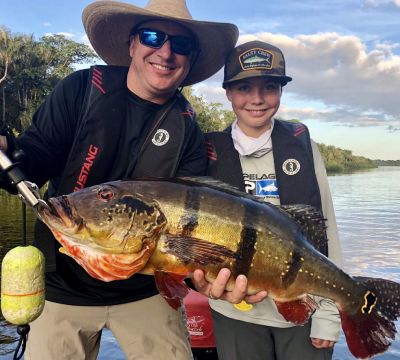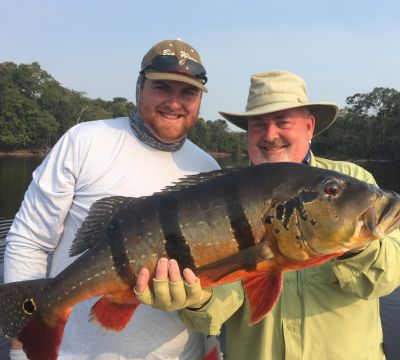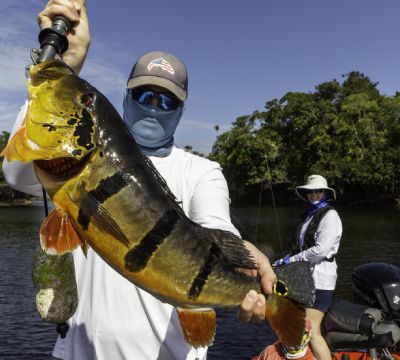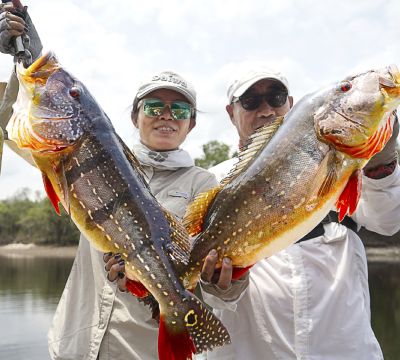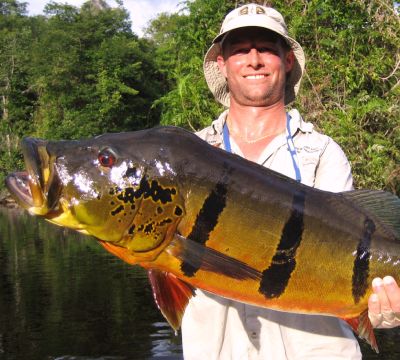
The Peacock Bass
The mighty Peacock Bass of Brazil’s Amazon has become one of the most sought after freshwater fish species in the world since its “discovery” in the early 1990’s.
This colorful, hard fighting fish is capable of reaching weights of upwards of 30 pounds, is an aggressive predator that will burst out of the water to smash huge, noisy topwater lures with a vengeance and fights like a bull when hooked. Even the species’ misses are impressive with them occasionally knocking a big 7” Woodchopper topwater lure 5 to 6 feet in the air on a missed strike. Although Peacock Bass resemble and feed like a Largemouth Bass, it is a member of the aggressive Cichlid family and not a true bass.
Also, Peacock Bass do not go off into deep water and sulk after they spawn; both male and females will protect their fry once the eggs hatch. Many times your guide will tell you to cast to a brushy point 8 or 10 times and you will think he is just killing time. Not true, your guide knows the type of cover big Peacock Bass like and if they are not actively feeding, they can be enticed into striking by casting to them a number of times and making them mad! Very often you will see a second Peacock trying to take the lure away from the one that has it. It can be very advantageous for the 2nd angler in the boat to cast right behind a hooked fish as it will quite often result in a double hookup.
Visualize a 25-pound Smallmouth Bass having a bad hair day and you’ll get an idea of what a Peacock Bass’ temperament and fighting ability are all about! Peacock Bass will readily strike jerk baits, spoons, jigs, and flies, but that explosive topwater strike on a big Woodchopper or Rip Roller is what people come to Brazil’s Amazon to experience.
Guests of Capt Peacock targeting one of the three species of Peacock Bass found in the upper Rio Negro of Brazil’s Amazon average 30 fish per day per boat and fish of more than 20 or even 25 pounds are not uncommon.
Tucunaré” in Portuguese, “Pavon” in Spanish & “Peacock Bass” in English

Once a week, from 8 pm to midnight, guests will experience this new and exciting method of fishing that utilizes specialized archery archery equipment to shoot and retrieve fish. Fish are shot with a barbed arrow that is attached with a special line to a reel mounted on the bow. “Fish” for giant catfish, massive freshwater stingrays (catch and release), and a host of other nocturnal species all under the backdrop of the Amazon Rainforest at night!
Peacock Bass are of the biological genus Cichla, commonly called Cichlids, and not a true Bass. These are some of the hardest fighting fresh water fish in the world.
Early in the mornings you seem to see a lot of activity in the shallow edges of small lakes and lagoons as the bigger Peacock Bass are chasing baitfish and juvenile members of their species. As the day goes on and the water in the shallows heats up, the bigger Peacock Bass do tend to move into the deeper water in the middle of the lagoons where the water is a little cooler. Thus, generally you will fish the shallow edges in the mornings and the deeper waters during the heat of the day.
Peacock Bass actually seem to suspend during the night and do not feed. Peacock Bass are predatory fish and love to lie in ambush for an easy meal. Prime places to fish are around cover, not only on the banks of rivers and lakes, but also around islands, submerged trees and flooded timber, as well as sandbar points located away from the shore. Although Peacock Bass will school and push bait fish to the surface, the bigger fish will most often be found lying in the shadows of brush, banks or sand bars in ambush mode.
The places you will look for in pursuit of big Peacock Bass (10 lbs. +) are points with submerged brush on them that drop into 8 – 15 feet of water. Points that drop off into 3 – 8 feet of water will usually hold smaller fish, except in the mornings. The exception to this rule is when the Peacock Bass are spawning around the sand bars located in the backwaters. Remember, the biggest fish will hold the most advantageous ambush sights, i.e.; points, stumps, etc. This is the main reason that heavy fly rods in the 10 weight class are necessary when “playing” with Peacock Bass in the 14 – 25 lbs. class and the use of the 65 – 80 lbs. test braided Kevlar on the bait casting and spinning gear.
Once a big Peacock Bass is hooked, he will head straight for the cover he feels safe in, and will give you more fight per pound than any fresh water fish you have ever hooked before. Peacock Bass have an abnormally large tail for their body size, which generates tremendous power. Do not overlook a solitary stickup, no matter how small, in the middle of a lagoon. Very often a big Peacock Bass will be holed up in its shadow in ambush mode. Cast to it, work you lure past the stickup and be sure you have a good grip on your rod!
What is known about these fish is that they will weigh upwards of 30 lbs., are structure oriented, will eat anything they can get into their mouth, and are extremely aggressive. All this and the seeming ability to make them mad enough to kill a noisy topwater lure that is repetitively run by them even though they are not actively feeding, makes them a prefect target for Sport fishermen.
Other Amazon Fish Species
There are over 2,500 documented species of fish in the Amazon River basin, adding a whole new perspective to the question, “What else can I catch?”
There are three species of catfish including the piraiba, which reaches lengths of nearly seven feet and weights of over 400 pounds; the prehistoric Arapaima that snakes to lengths of 10 feet or more and can weigh over 400 lbs.; three species of piranha each weighing over 5 lbs.; the ancient Arowana that explodes upwards of five feet out of the water to catch birds and small mammals from overhanging brush; a myriad of different species of Oscars, and tiny freshwater tropical fish the likes of Tetras and Angel fish.
There are so many species of fish that dropping a piece of cut bait in the deep channels of the river or casting a small crankbait into the shallows will sometimes procure a fish that your guide, who grew up on the river fishing nearly every day of his life, has never seen before. Fishing in Brazil’s Amazon is the epitome of “exploratory fishing!”
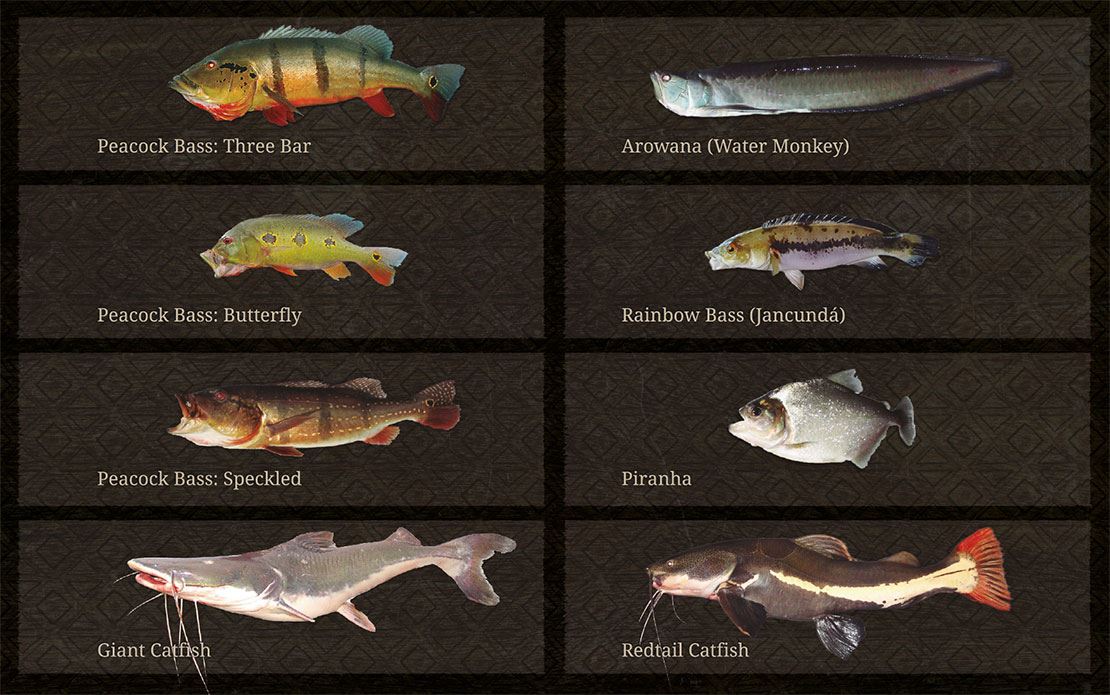
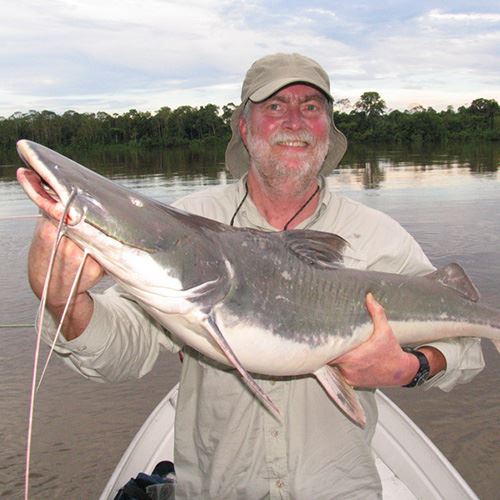
Giant Catfish
Of the myriad of different species of fish that inhabit the waters of the Rio Negro river basin 1,200 of them are one type of catfish or another. From the tiny inch long Candiru to the large 10 ft. Long Piraiba, the catfish of the Rio Negro and its tributaries, offer a wide variety of shapes, sizes, colors and body conformations.
The southern ideal of spending a lazy aft.ernoon of fishing for a fried catfish dinner can take on a whole different twist in the Amazon! Dropping a chunk of cut bait, be it Piranha or a piece of chicken, will quite often hook into much more than you bargained for. This is the one place in the world where the catfish would “noodle” for the fisherman, rather than the fisherman noodling for the catfish!
Most of the fishing for catfish is done in the aft.ernoon from 3:00 pm into the night when the catfish move into their feeding lanes in the currents around islands or sandbars. Captain Peacock Expeditions provides what looks like salt water tackle, short heavy pool cue like boat rods and heavy Penn Squidder type reels loaded with 80+ lb D on or monofilament line and 7/0 circle hooks! Live bait or cut bait is used, be it fish, chicken or whatever will entice these aggressive predators. Everyone needs to try this “game” one time as it adds a totally new dimension to your Amazon fishing trip. Of the 1,200 species of catfish that live in the waters of the Rio Negro, below is a short description of the 3 types you will most often catch.
Piraiba is considered the largest catfish in the Amazon River basin, reportedly exceeding 8 feet in length and weighing in excess of 400 lbs. It belongs to the genius Brachyplayreatstoma , which contains 7 of the largest freshwater fish in the world. A monster weighing 295 lbs. is the largest verified member of this species ever caught on rod & reel. Sporting a grey body with a white underside, the Piraiba will often have barbules nearly as long as it’s body. Extremely strong and agile, this fish will make long smoking runs and will occasionally jump clear of the water. It can be a little disconcerting when the fish you have been fighting surfaces and is half as long as the boat you’re fishing from! This fish grows so large that the people of the river call juvenile fish (under 200 lbs.) Filhote, and only mature fish over 200 lbs. are referred to as Piraiba!
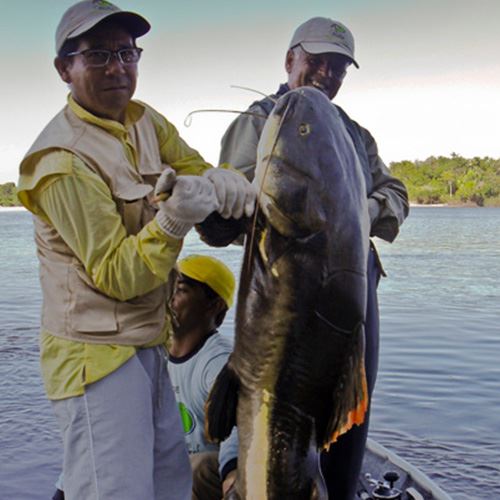
Pirarara (Red Tail Catfish)
The Red Tail is the glitzy “painted lady” of the Amazon’s catfish family. Dark gray, sometimes with an almost a black upper body, a cream colored underbelly sporting a bright orange fringed dorsal fin & tail, this baby looks like you would expect your four-year daughter to look like when she got into her mother’s makeup kit without supervision!
Sporting a “polliwog” shaped body up to 5 ft. Long and weighing upwards of 200 lbs. The Red Tail has plates on its head that give you the impression of a turtle’s shell. This monster does not display the agility of a Piraiba but makes up for it in reel emptying raw power. This species is the one you will most probably catch the most of and is excellent table fare.
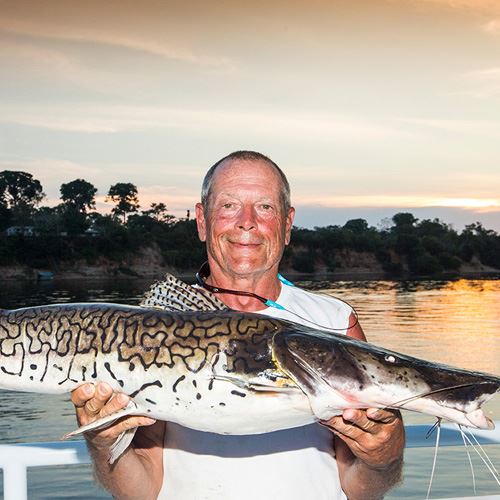
Barred Sorubim (Tiger Catfish)
The Barred Sorubim is occasionally referred to as the “Tiger Catfish” and aptly so. This long, streamlined catfish can be up to 4 feet in length, has the shovel head and snout similar to a Northern Pike with a light silver gray body with a white underbelly and cream to white sides sporting “racing stripes” down its body from head to tail.
Although this fish has been reported to reach 100 lbs., the majority of this species you will see will weigh 5 – 20 lbs. The Sorubim is more of a midlevel to topwater feeder than a bottom feeder like most catfish. It is not unusual to catch them while fishing a jerk bait or jig for Peacock Bass and they have been caught by fly fishermen using great Deceiver, and Clouser pattern flies. These fish are excellent eating.
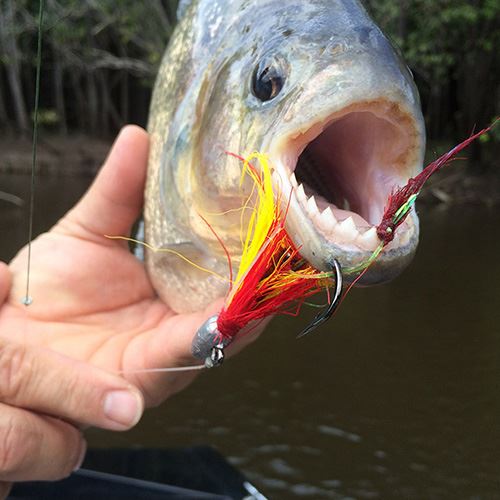
Piranha
You will have an opportunity to catch three species of Piranha fishing the areas Captain Peacock operates on the upper Rio Negro watershed, one of the Amazon River’s black water tributaries. White and Black Piranha are the most common, often weighing over 5 lbs. The Red-Piranha will weigh up to 1 lb and are the most aggressive.
The basic rule of thumb from the indigenous people of the region is if the water is moving, like the open river, it is safe to swim even though the water is loaded with Piranha. If the water is still, like a backwater lagoon or a land locked lake, you stay out of the water! You will almost always find these aggressive fish in large schools and when you catch one keep fishing in the same area if you want to have a meal of these delicious fish. Piranha takes little nips with their razor sharp teeth and can trim a fly back to the hook without you ever feeling a strike. They will readily hit Rattle Traps and small jerk baits as well as cut or live bait. Piranha are found throughout the regions in shallow or deep water. No trip to the Amazon is complete without catching a Piranha!
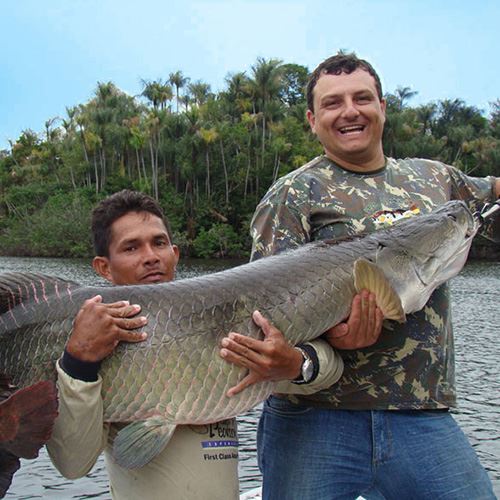
Arapaima (Pirarucu)
This prehistoric lung breather, dating from the Jurassic period grows up to 10 ft. Long weighing over 400 lbs. Pirarucu, as they are called by the people of Brazil’s Amazon, are not an ordinary fish but are occasionally caught on jerk baits while fishing for Peacock Bass.
Adapted to living in shallow oxygen depleted water these fish have the ability to gulp air while their gills are used mainly to eliminate CO2 from their blood stream. The indigenous peoples of the Amazon will use the scales of this fish, some larger than a silver dollar, like finger nail files. The flesh of the Pirarucu is some of the finest eating of any fish in the world. The majority of these huge fish are speared as they porpoise on the surface gulping air.
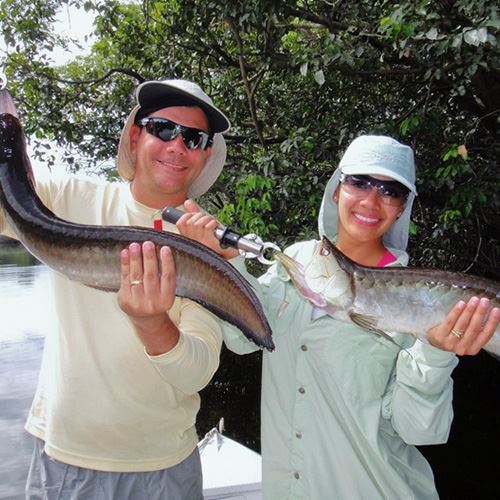
Silver Arowana (Water Monkey)
Commonly called the “Amazon Water Monkey,” due to its ability to jump 6 feet out of the water to snag small birds and insects from branches and vegetation overhanging the river, the Arowana is another ancient relic dating back unchanged nearly 170 million years.
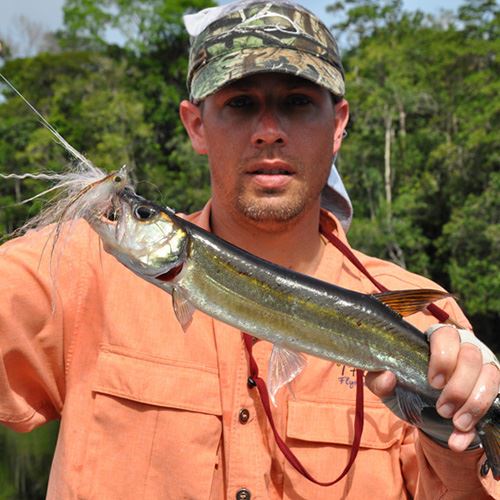
Bicuda or Picua
The bicuda/argulha is an aggressive, fast water fish that can be found in the rivers Amazon. It can reach sizes of over 15-pounds and is a powerful, acrobatic fighter.
Once hooked, they launch themselves into the air, rattling their gills and throwing hooks. Larger specimens are found in the fast water rivers of northern Brazil.
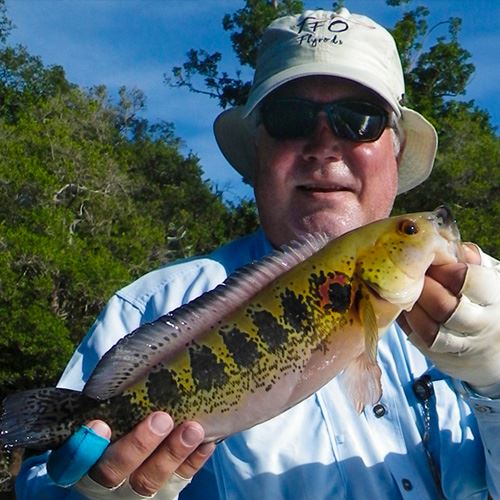
Oscars & Jacunda (Rainbow Bass)
Oscars and Jacuda, commonly called Rainbow Bass by American anglers, are of the same family as the Peacock Bass, Cichlids. The Oscars, with a body conformation much like a Sunfish & weighing up to 2 lbs. know how to use their slab sided body to significant advantage when hooked.
Oscars are caught around fallen trees and submerged brush on small crank baits or small bright flies. Jacuda is an unusual elongated fish with a myriad of dark stripes on its green body, a distinctive red spot just behind the gill plates and a dorsal fin running all the way to its tail. These fish, growing up to 18 inches and weighing up to 5 lbs., are most often caught on small crankbaits and flies and will put up a good fight on light tackle.
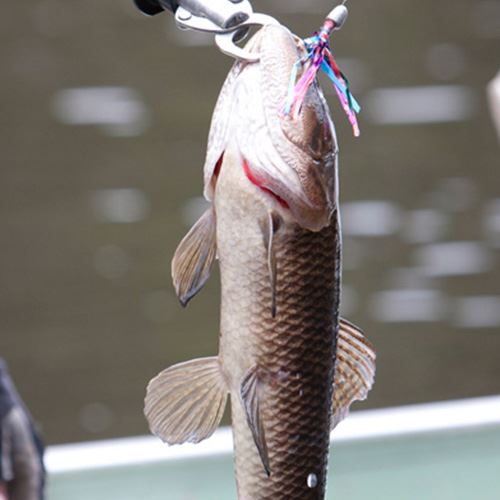
Traira (Dog Fish)
Traira, commonly called Dog Fish by American Anglers, are relatively small fish with a mouthful of triangle teeth that will get your attention when you bring them aboard.
These fish, up to 18 inches and length and weighing up to 3 lbs., give you the impression of a freshwater mullet with a mouth full of teeth that look like they came out of a meat grinder! Found in shallow water with mud bottoms, Traira are very aggressive and will strike jerk baits and flies with a vengeance. Fishing guides are much more careful when taking a Traira off the hook than they are with a Piranha.
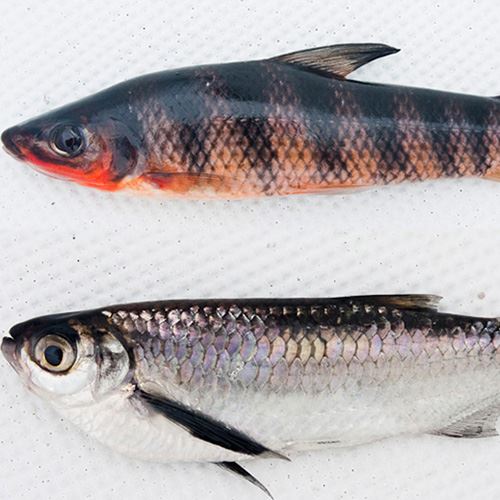
Amazon Baitfish (Aracu & Sardina)
The Amazon basin holds a myriad of small bait fish, many of which are netted by the indigenous people of the rivers to be sold to the tropical fish trade. Tetras, Angel Fish and much more provide food for the larger predatory fish of the river systems.
Two of the most important to the Peacock Bass fisherman are the Aracu, smoked yellow bait fish with dark gray stripes and orange fins and throat growing up to 15 inches & the Sardina, a perfect freshwater copy of the saltwater Sardine or Pilchard that will grow up to 6 inches. It is not unusual to see an Aracu suddenly jump and sail 20 feet across the water to get away from a pursuing Peacock Bass. A good part of the jigs and topwater woodchopper type lures used for Peacock Bass fishing are painted up in orange and black or silver and black to imitate Aracu or Sardinas.

